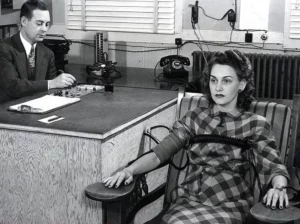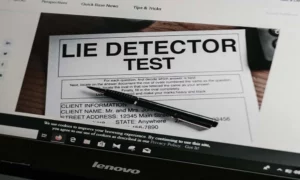Polygraph tests have been used for decades as a tool to detect deception in various settings, from criminal investigations to pre-employment screenings. Despite their widespread use, there is ongoing debate surrounding their accuracy and reliability.
In this article, we discuss the accuracy of polygraphs based on our own personal experience. We demonstrate how contradictory and misleading information can be found on the web and in books, and we conclude with our own practical, neutral insights on the numbers behind its accuracy.

Conflicting claims regarding polygraph test accuracy
The American Polygraph Association says that its trained examiners can get an accuracy rate of more than 90%. Its website claims that thousands of its members give polygraph tests around the world every year to protect the public by verifying the truth, while the American Psychological Association says lie detectors don’t work.
The truth is, there is plenty of conflicting evidence swaying in favor of lie detectors and against them. One problem, research shows, is that humans have a tendency to lie from a young age, mastering the “white lie” by age 6. As people grow, some will become pathological liars, which could affect how they react and respond if given a polygraph.
Organizations and scientists studying polygraphs found that it’s difficult to assess how well they work because there are too many definitions of deception. Early theorists believed that deception required effort and, thus, could be assessed by monitoring physical changes.
Since then, studies have found many ways of measuring the results of deceit, and many times they have been deemed “inconclusive.”
A 2003 report from the National Academy of Sciences discovered that after almost a century of research in scientific psychology, there is little basis for believing that a polygraph could have the type of accuracy that the APA claims. Critics say the underlying problem is theoretical since a person’s physiological changes might occur for a variety of reasons other than lying.
For example, studies show that individuals from certain cultural backgrounds may have different physiological responses to stress, which can affect accuracy. Additionally, those who are particularly anxious or nervous may be more likely to produce false positives, while individuals who are highly skilled at deception may be able to produce false negatives.
The examiner’s voice alone could trigger a naturally anxious individual, and an honest person may be nervous when answering truthfully, whereas a dishonest person would not be.
Additional studies claim the accuracy to be 70–90%, pointing out that only 29% of the results put forward by “polygraph advocates” met the minimum standards of scientific adequacy.
Factors That Can Affect the Accuracy of Polygraph Tests
There are a number of variables that can influence the accuracy. These can range from the physiological responses of the test-taker to the type of questions being asked.
The test is traditionally divided into three segments: the pre-test, the examination, and the post-test. Each of these has the potential to impact accuracy.
- A major factor that can alter it is your emotional state. As mentioned, individuals who are especially anxious or nervous may produce responses that can be interpreted as deception. Additionally, if you are experiencing intense emotions, such as fear or anger, you may produce responses that mask your true reaction to a question.
- Another aspect is the type of questions being asked. If they are too general or ambiguous, it can be difficult to determine whether you are being truthful or not. Similarly, if they are too leading or suggestive, you may be more likely to provide a false response. In some cases, the wording of the questions may also be culturally biased, which can affect accuracy for individuals from certain backgrounds.
- If the examiner is not properly trained, they may be more likely to misinterpret the results or make other errors that could affect accuracy. Additionally, his personal biases or preconceptions about you may also influence their interpretation. For example, an examiner who believes that you are guilty may unconsciously influence the results by framing questions in a way that is more likely to elicit a deceptive response.
- Age and gender: Studies show that older individuals and women may produce more false positives due to changes in the autonomic nervous system and hormonal differences. However, this effect is relatively small and should be considered in conjunction with other factors.
- Mental or physical condition: Individuals with either mental or bodily conditions that could affect their physiological responses may produce inaccurate results. For example, those with high blood pressure or heart conditions may produce false positives, while individuals with neurological disorders may produce false negatives.
- Different drugs and illegal substances like anti-hypertensive and anti-anxiety medications, can influence accuracy by altering physiological responses and impairing cognitive functioning.
- During the examination, you will be attached to several devices. It is the responsibility of the examiner to ensure these devices are securely attached. If they are not, precision could be affected by not reading your physical responses properly.
- If you are highly uncomfortable, this could also affect the readings. This scenario could be caused by the examiner or the environment of the test.
- In the post-test stage, accuracy can be affected if the results are misread.
Overview of the results of various studies on polygraph test accuracy
Numerous studies have been conducted regarding accuracy of lie detectors, with inconsistent results.
One of the earliest and most well-known ones was done by John Reid in 1947. Reid tested the accuracy by asking participants to either tell the truth or lie about a crime they had committed. He found that they were accurate in 89% of cases.
Among the most frequently cited studies is a meta-analysis conducted by the National Academy of Sciences in 2003, which concluded that the accuracy is no better than chance. This finding is based on an analysis of over 80 studies carried out on the use of polygraphs in criminal investigations and employment screening.
However, more recent research produced mixed results. For example, one study conducted by the National Research Council in 2003 found the accuracy to be between 80% and 95%, depending on the type of test used and the qualifications of the examiner.
Another study carried out by the American Psychological Association in 2012 found that the accuracy varies depending on the context in which they are used. In situations where the stakes are high, such as criminal investigations or employment screening, it tends to be lower. In contrast, it tends to be higher in lower-stakes situations, such as academic research or military screening.
In a review of the literature on lie detection tests published in the Journal of Applied Research in Memory and Cognition in 2018, the authors concluded that while some evidence supports the use of them in specific contexts, their overall accuracy remains questionable. The authors also noted that there is a need for more research on the precision of newer, computerized polygraphs.
Explanation of the limitations of this research
While the studies discussed provide valuable insights, there are several limitations that must be taken into account.
- One major drawback is the lack of standardization in polygraph testing procedures across different studies. This can lead to inconsistent results and make it difficult to compare findings. For example, different research may use different questions, different methods of scoring the test, or different physiological measures to detect deception.
- Another problem is the use of simulated rather than real-life scenarios. Many studies used laboratory-based simulations, which may not accurately reflect the complex and dynamic nature of real-life situations where deception may occur. Participants in these studies may not feel the same level of stress or pressure as they would in a genuine situation.
- A further limitation is the potential for bias in the studies themselves. For example, researchers conducting them may have their own beliefs or expectations, which could affect the way they design or interpret their results. Additionally, studies funded by organizations with an interest in promoting the use of polygraph tests may be more likely to report positive results than studies conducted independently.
Comparison of the accuracy of polygraph tests to other forms of lie detection

The polygraph is not the only method available. Other kinds of lie detection include the following:
- Voice stress analysis: This technique analyzes changes in the pitch and tone of a person’s voice when answering questions. However, it has been criticized for lacking scientific validity.
- Micro expressions: These are brief facial expressions that reveal a person’s true emotions. While some experts believe they can be used to detect lies, others argue that they are completely unreliable indicators of deception.
- Eye-tracking: This measures the movement of a person’s eyes when answering questions. Some studies suggest that it can be a fairly reliable indicator of deceit, but more research is needed.
- Brain imaging: This involves the use of MRI or fMRI scans to measure brain activity. This method is still in the experimental stage, and more research is needed to determine its precision.
- Behavioral analysis: This involves observing a person’s behavior, such as body language and speech patterns, to detect signs of deception. While it can be useful, it can be influenced by personal bias and interpretation.
Overall, accuracy of these methods varies, and none of them can be considered completely reliable.
None of these can detect lies with 100% accuracy. Human behaviour is complex, and people can deceive in a variety of ways.
Encouraging truth telling
Although accuracy of a polygraphs cannot truly be measured and concluded as scientific evidence, it is still used by probation officers, law enforcement, and government agencies. But why?
One popular theory is that they may appear to be accurate because the person taking them believes they work.
Polygraph research has not separated placebo-like effects from the actual relationship between deception and physical responses. If you believe they work, you may be very nervous and tell the truth when asked. Exams encourage candidates to tell the truth.
In 2014, forensic psychologist Theresa Gannon studied the likelihood of sex offenders disclosing something of interest when using a polygraph test vs. no test at all. They discovered that with a polygraph, their participants were 75% more likely to confess something of interest, compared to 51% without one.
So, in some situations, whether the tests work is beside the point. They are often used to simply scare examinees into confessing or answering truthfully during a pre-screen.
Overall, it only gets people to cooperate a large majority of the time.
Famous cases of inaccuracies

There have been many high-profile cases of guilty individuals passing polygraph tests.
In 1985, Mark Hoffman, who was later found guilty of the two murders he was questioned over, passed his exam with exemplary results.
He was later convicted and told news outlets how he beat it, giving him more time to commit crimes. Hoffman admitted to practicing self-hypnosis to “split his personality” as well as using a blood pressure kit daily to control his reactions to questioning.
In another famous case, the Green River Killer, Gary Ridgway, passed a police polygraph test in which he stated he had no connection with the disappearance of some women local to the area. Ridgway would be dropped as a suspect, setting him free to kill 44 women until he was caught and convicted.
KGB spy Aldrich H. Ames, who was found culpable in the deaths of 48 CIA agents, passed two CIA lie detectors with no issues. He later explained, “There’s no special magic.” “Confidence and a friendly relationship with the examiner…”
The Angel of Death, nurse Charles Cullen, murdered as many as 40 people by administering lethal injections. After his first victim died, Charles was asked to take a polygraph exam, which he passed. The failure of this exam resulted in the deaths of 39 more people.
Conversely, there have also been some high-profile cases of innocent people failing their lie detector tests.
When Vicki Wegerle disappeared in the 1980s, her husband failed both his police lie detector test and a privately hired expert one. In 2005, DNA evidence proved that Mrs. Wegerle was a victim of the BTK killer, Dennis Rader, a serial killer during the years 1974–1991.
In New York City, in 1988, an innocent Frank Sterling failed a polygraph during the murder investigation of Viola Manville. After he failed, law enforcement coerced him to confess, and Sterling was sentenced to 22 years in prison for a crime he did not commit.
The killer, Mark Christie, who was also a suspect, passed it, giving him years to commit crimes such as abducting and murdering a four-year-old girl. When convicted of this crime, he confessed to the killing of Viola Manville, and Frank Sterling was released from prison.
In 2003, the National Academies of Sciences asserted that there is evidence that honest test subjects fall into “socially stigmatized groups.”
These are individuals who are already believed to be guilty because they may show emotional and physiological responses that could mimic the responses that are expected of a guilty person.
Accuracy of polygraph tests: our practical insights

There is an overwhelming amount of conflicting information regarding accuracy of polygraphs. Advocates such as the APA claim a close to 90% rate, while other studies claim much lower statistics, pointing out variables such as personality type, a person’s ability to deceive, how deception is measured, reaction to triggers, and an individual’s stress levels, guilty or innocent.
Using our actual experience as our basis, we found that the lie detector’s accuracy is exceptionally high and typically ranges between 88% and 98% in real-world examinations, as opposed to study environments, with an average of 95% for each test taken.
Given the potential for a 5% margin of error on standardized exams, the majority of official organizations offer a second exam for test-takers who fail. Assuming that the two tests are independent (if the procedure is carried out properly, they should be as independent as possible), the probability of failing to detect deception in both tests would be:
0.05 x 0.05 = 0.0025 (or approximately 0.25% when rounded to two decimal places).
Hence, the probability that the polygraph would fail to detect deception after two independent tests is approximately 0.25%, indicating that, on average, approximately 99.75 percent of deceptive individuals would be identified as such by both examinations.
This indicates a high degree of precision. Though it is less than 100%, these rather high results show that the procedure is generally accurate.
The issue we have identified is that out of the 5% margin of error, the majority of the applicants that fail were truthful (false-positives) and comparatively less dishonest (false-negatives) ones. This is due to a number of reasons, including psychological, case-related, and procedure-related aspects.
Another concern is that in many cases, private sector polygraphers disregard these statistics and depend entirely on the findings of a single test.
It’s worthwhile to point out that, typically, these are the upper and lower limits that vary based on the individual’s personality, the examiner, the case history, and the type of test.



